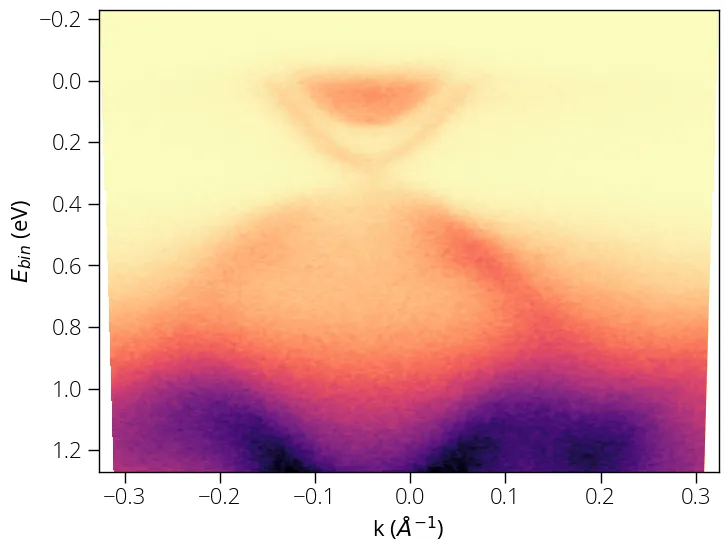k-space conversion
The electron analyzer records the intensities in angle and kinetic energy. In order to convert convert into k-space we can use the following formula:
In the above expression, photon momentum is ignored, which is good approximation for photon energies in UV range or lower. If high photon energy is used (e.g., soft-x-ray), we will need correction for photon momentum.
The input data is in uniform grid of angle (degree) and energy. After point-wise conversion, we no longer have uniform grid in k-space. In order to store the data in uniform grid, we make use of interpolation.
The k_conv function can convert two-dimensional Energy vs theta data to
binding energy vs (momentum). Here binding energy below the Fermi energy is
positive convention used.
import arpespythontools as arp
data, energy, angle = arp.load_ses_spectra('sample_spectra.txt')
data_k, e_bin, k = arp.k_conv(data, energy, angle, 16.67)
# Fermi energy = 16.67 eV
# Plot image
import matplotlib.pyplot as plt
%matplotlib inline
# Above line is specific to Jupyter Notebook
plt.figure(figsize = (8, 6))
plt.imshow(data_k, origin = 'lower', aspect = 'auto', \
extent = (k[0], k[-1], e_bin[0], e_bin[-1]))
plt.xlabel("k ($\AA^{-1}$)")
plt.ylabel("$E_{bin}$ (eV)")
plt.set_cmap('magma_r')
plt.show()
Which would produce a plot like this:

k-space conversion for 3D Fermi map data
Similarly, we can convert three dimensional (Energy, theta, phi) Fermi map data
to -space by using k_conv3d function.
data, energy, theta, phi = arp.load_ses_map('sample_map_data.zip')
data_k, e_bin, kx, ky = arp.k_conv3d(data, energy, theta, phi, 16.67)
# Fermi energy = 16.67 eV
Depending on the size of data matrix and computing power, the k_conv3d might
take several minutes to complete.
Multiprocessing version
There is also a multiprocessing implementation of the k_conv3d, which should
be up to as many times faster as many processor cores are available.
data_k, e_bin, kx, ky = arp.k_conv3d_mp(data, energy, theta, phi, 16.67)